ASUS F2A85-V Pro Review: A Look at FM2 with A85X
by Ian Cutress on October 10, 2012 11:20 AM EST- Posted in
- Motherboards
- Asus
- Trinity
- FM2
- A85X
USB Speed
For this benchmark, we run CrystalDiskMark to determine the ideal sequential read and write speeds for the USB port using our 240 GB OCZ Vertex3 SSD with a SATA 6 Gbps to USB 3.0 converter. Then we transfer a set size of files from the SSD to the USB drive using DiskBench, which monitors the time taken to transfer. The files transferred are a 1.52 GB set of 2867 files across 320 folders – 95% of these files are small typical website files, and the rest (90% of the size) are the videos used in the Sorenson Squeeze test.
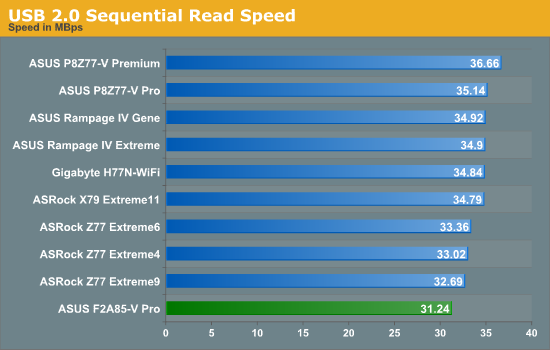
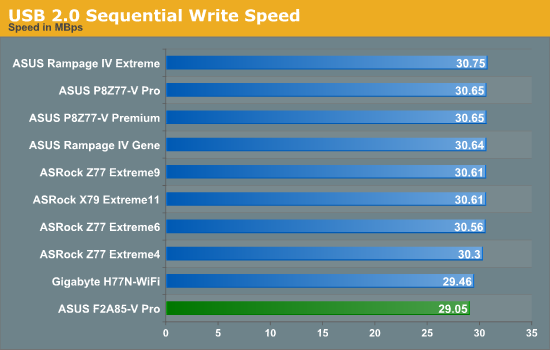
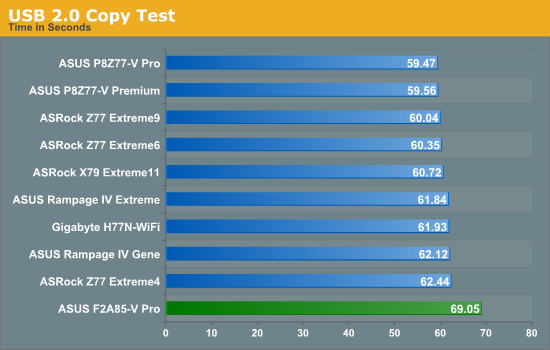
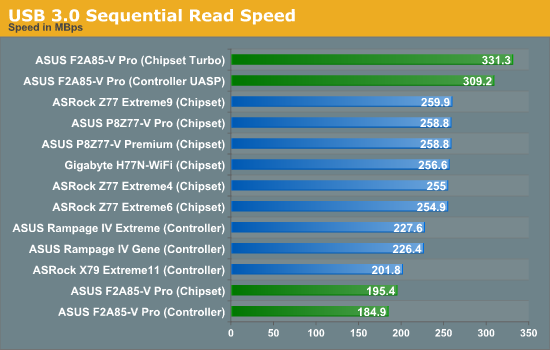


For whatever reason, our standard USB testing regimen on AMD systems shows a slight speed deficiency compared to the Intel systems. In USB 3.0 our copy tests are more than 10% slower on an AMD system.
SATA Testing
We also use CrystalDiskMark for SATA port testing on a C300 drive. The sequential test (incompressible data) is run at the 5 x 1000 MB level. This test probes the efficiency of the data delivery system between the chipset and the drive, or in the case of additional SATA ports provided by a third party controller, the efficiency between the controller, the chipset and the drive.

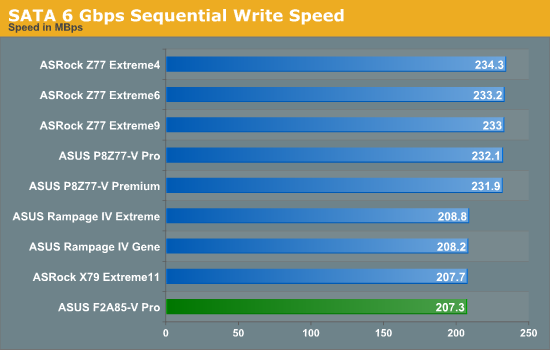
I really like the fact that the AMD chipset is SATA 6 Gbps only, although we see that SATA peak write speeds on this board are slightly lower than that of most Intel boards. Previously this is normally attributed to BIOS settings at default.
DPC Latency
Deferred Procedure Call latency is a way in which Windows handles interrupt servicing. In order to wait for a processor to acknowledge the request, the system will queue all interrupt requests by priority. Critical interrupts will be handled as soon as possible, whereas lesser priority requests, such as audio, will be further down the line. So if the audio device requires data, it will have to wait until the request is processed before the buffer is filled. If the device drivers of higher priority components in a system are poorly implemented, this can cause delays in request scheduling and process time, resulting in an empty audio buffer – this leads to characteristic audible pauses, pops and clicks. Having a bigger buffer and correctly implemented system drivers obviously helps in this regard. The DPC latency checker measures how much time is processing DPCs from driver invocation – the lower the value will result in better audio transfer at smaller buffer sizes. Results are measured in microseconds and taken as the peak latency while cycling through a series of short HD videos - under 500 microseconds usually gets the green light, but the lower the better.
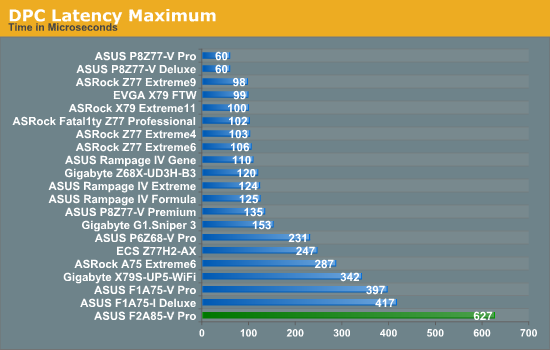
Normally our DPC Latency tests can be affected by monitoring software, producing a value north of 1000 microseconds. Anything under 500 is acceptable, and under 200 is great. However the F2A85-V Pro gets a value in the 600s. During the test, the DPC would hover between 100 and 200 most of the time, but every now and again would peak in the 600 region for whatever reason. The system was rebooted a couple of times but this behavior was persistent across boots. As of the 5104 BIOS this would be slightly worrying for audio work.










66 Comments
View All Comments
medi01 - Sunday, October 14, 2012 - link
What kind of enthusiasts need CPU more than GPU?Urizane - Monday, October 15, 2012 - link
'Enthusiast' is not exactly equal to 'Gamer'. Gamers don't really need a ton of CPU capability. Enthusiasts may have many CPU bound interests.dsrnet - Monday, April 15, 2013 - link
hi,What is the best 4 core processor ( CPU ) ,stating its clock speed,that it supports? ( F2A85-V PRO mother board ), please let me know.
thanks
Aj
tim851 - Thursday, October 11, 2012 - link
Hehe, my thoughts exactly. I don't hate AMD and wish them a lot of success - primarily for my own sake - but no enthusiast is thinking about Trinity.zappb - Wednesday, October 10, 2012 - link
Ian, What do you think about pairing a low end FM2 processor with a micro ATX version of an A85 or A75 boardBenefits I can see for small office machine that has standard admin workloads - (to compete with the recent budget systems buyer guide say with the pentium G530 recommendation).
Buy going with the Trinity you get -
lower idle power consumption and mostly this builds will run word-excel etc..., so lower TCO
Ability to run 2 monitors and keep lowish power (no need for new GFX) also better GFX in general
Ability to upgrade / more flexibility - with one more processor release arriving for FM2 next year and better chipset options.
Can run encryption / AES - ok not a great processor choice in general but as more small firms realise how important security is, it could be as simple as running 7zip 256 Bit encryption on a few files before emailing them - the processor is not handicapped and Trinity should buy and sell the Pentium in speed.
So take an AMD A4-5300 - 65 USD, and some A85 micro atx variant for say 70 USDand pair it will an Samsung 830/840/ Intel 330128 GB SSD I would suggest this might be a better long term platform than the Intel/G530 combo recommended in the value system buyers guide.
What's the cost? An Extra 40 USD on the low end intel?
just4U - Wednesday, October 10, 2012 - link
Would work fine I'd expect.. but without hands on testing of a lower end FM2 part .. I'd be rather curious about it's overall performance.. Looking at bench results the A10 5800K is in and around 1156 I5 performance (slightly lower on single thread) but very comparable to Quad9X C2D stuff.. which is decent overall with all the additions that come with future tech and ofcourse the graphics.I rather like the 5800/A85X combo myself but it should be about $40 bucks cheaper then it currently is. Still.. not having a problem with it on our secondary system (a 2700K build for the main..) It's certainly fast enough.
just4U - Wednesday, October 10, 2012 - link
Also, one of the things I've seen reviewers mention is .. these new Trinity based setups could make quite the showing in the office or in the living room. I plan on setting up a low cost option for our living room as more selections in boards start to come out.... I also like the fact that the system stays cool.. a major complaint of mine with the Ivy Bridge cpu's that rarely gets even a mention.
CeriseCogburn - Saturday, October 13, 2012 - link
LOL - it's all too clear, and has been for a very long time. AMD fanboyzappb - Saturday, October 13, 2012 - link
Throughout the review, Ian was looking for a reason to recommend why someone would buy FM2.In the context of Zach's excellent value buyer's guide here: http://www.anandtech.com/show/6182/fall-budget-sys...
In that article Zach recommends a Intel Celeron G530 which is insanely cheap at USD 30 but doesn't have some of the instruction sets that AMD don't cut out from cheaper models.
With the motherboard there's about 100 dollars to play with for CPU and Mobo. A75X + low end FM2 - well there just might be room for the right priced FM 2 setup - which might even also be lower power and more flexible.
I'm shortly building 4 machines in our office to replace the final load of XP machines (Win7/Office 2010). It's an accounting office and users tend to use alot of excel and quickbooks. Nothing too taxing on the client side. It will be a tough decision between Intel and AMD.
jabber - Monday, October 15, 2012 - link
Trinity is more than enough for most office workloads.I rolled out a load of dual core Atom boxes for office use between 2010-2011.
Yeah dual core Atoms. Quite pathetic in comparison to Trinity but no complaints, I regularly ask the staff how they are getting on with them and they all still love them.
Folks here are just a little too autistic to see that not everyone works (well for some here I bet the term work is an alien concept in the truest sense) like they do or sees the world in such benchmark obsessed terms.
Most folks have been sorted CPU wise for office work since 2005/6. The stuff most of us play with here is for rich kids toys.